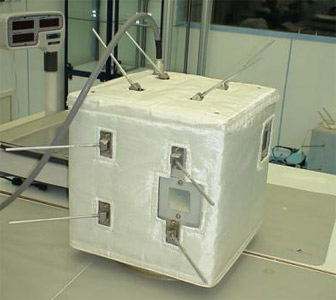 The Omid satellite itself looks to mass about 15-20kg, 25kg tops. There's what looks like a GPS orientation system, some comms, a battery, and little else. Lifetime maybe a week. No attempt at stabilisation, the antennae are omnidirectional. The kind of microsat regularly put up by universities as class projects. Simple, but that's good, less can go wrong.
The Omid satellite itself looks to mass about 15-20kg, 25kg tops. There's what looks like a GPS orientation system, some comms, a battery, and little else. Lifetime maybe a week. No attempt at stabilisation, the antennae are omnidirectional. The kind of microsat regularly put up by universities as class projects. Simple, but that's good, less can go wrong.
A space-hardened GPS system is very sensitive technology, and if this is one, one wonders how it escaped into the wild. But given the relatively benign radiation environment at 350km altitude, and the short life, a commercial military standard one might have been used. Not exactly a dime a dozen, but easy to procure and to integrate using commercial avionics techniques. Pure speculation on my part though.
I really hope that's an engineering model not the flight model in the picture, as they're certainly not operating under cleanroom conditions.
From Arms Control Work :
Here are some rough numbers (which I expect Geoff will improve on) based on my analysis of the North Korean TD-1 launch in 1998, and assuming that the Safir is similiar in capability to the TD-1. This seems like a reasonable assumption from the parameters of the missile.I think he's being a bit generous, I'd expect a "beginners" nuke to mass at least 2000kg with the re-entry shielding. Anyway, this is not an ICBM of the same class that launched Sputnik, nor even the one that launched Explorer. It's not an ICBM at all, in fact, more like the Thor IRBM. Good enough to reach Israel, and maybe southern europe, but not with a nuke, only a warhead half the size of a V2's.
The orbit given for the objects requires a speed of about 7.7 km/s. My estimate is that the first two stages could have achieved a speed of about 3.5 km/s (this is based on an analysis of splash-down locations of the first two stages from the 1998 NK launch). That means the third stage would have had to give a delta-V of about 4.2 km/s. Assuming the satellite is very low mass (about 20 kg), that appears to be achievable with small solid stages that may be commercially available.
If this missile attempted to launch a significantly larger mass, the range would be much less. My estimate is that the range would drop to about 2500 km for a 1000 kg payload, which may be what a nuclear warhead would weigh, or about 4000 km for a 500 kg payload.
— David Wright · Feb 3, 10:24 AM ·
On the other hand, they did orbit a satellite. There are two new objects up there now, one the terminal booster, the other the Omid R&D sat. The Iranian team deserves congratulations on their success.
The animation put out by the Iranians (see below) indicates a 2-stage rather than 3-stage booster.
From Iran Daily Opinions Service:
The satellite has a mass of 27 kg (ISA web) or 25 kg (IRINN news agency) and it is a 0.40m cube. It carries an instrument to measure the space environment, and a GPS receiver modified for use in the unstabilized (i.e. tumbling) satellite, according to the Iranian Space Agency web site isa.ir.Now on to the physics package. From the Los Angeles Times:
...
The first Iranian satellite was launched into orbit on Feb 2 at around 1834 UTC +/- 5 min on a southeastern trajectory from an unidentified launch site in Iran. Two objects are in orbits of 245 x 378 km x 55.51 deg and 245 x 439 x 55.6 deg; radio signals picked up by Bob Christy, Sven Grahn and Greg Roberts confirm that 2009-04A is the Omid payload and the 2009-04B is the Safir rocket final stage. Omid’s orbit is close to the announced plan of a 250-350 km altitude.
Little more than a year after U.S. spy agencies concluded that Iran had halted work on a nuclear weapon, the Obama administration has made it clear that it believes there is no question that Tehran is seeking the bomb.One could be forgiven for thinking that now "their man is in", there's no need to dissemble. It wouldn't be the first time that people were "economical with the truth" regarding intelligence assessments in pursuit of political goals.
In his news conference this week, President Obama went so far as to describe Iran's "development of a nuclear weapon" before correcting himself to refer to its "pursuit" of weapons capability.
Obama's nominee to serve as CIA director, Leon E. Panetta, left little doubt about his view last week when he testified on Capitol Hill. "From all the information I've seen," Panetta said, "I think there is no question that they are seeking that capability."
The language reflects the extent to which senior U.S. officials now discount a National Intelligence Estimate issued in November 2007 that was instrumental in derailing U.S. and European efforts to pressure Iran to shut down its nuclear program.
 By way of comparison, here's a picture of FedSat (mass 55Kg) under assembly....
By way of comparison, here's a picture of FedSat (mass 55Kg) under assembly....
 And completed.
And completed.

2 comments:
The Iranianteam deserves congratulation, but one wonders whether the congratulations will be delivered air-to-ground.
"Good enough to reach Israel..."
Which is good enough to make a few people concerned. Not enough to make them loose sleep, mind you ;-)
Post a Comment